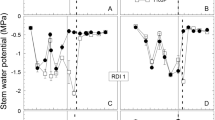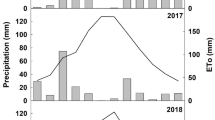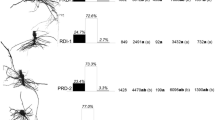Abstract
The effects of several moderate irrigation regimes on vine water status, yield, and must and wine composition, were investigated during five seasons in a vineyard planted with Vitis vinifera cv. Tempranillo. Treatments consisted of non-irrigated vines and six differentially irrigated treatments with contrasting watering regimes during the pre-veraison and post-veraison periods. There were large differences in yield and grape and wine quality responses to irrigation among seasons, probably as consequence of the different environmental conditions and crop levels. It was, however, clear that vines benefit more of the irrigation supplied in years of high yield levels. Across seasons, yield increased in proportion to the amount of water applied mostly due to the larger berries of irrigated vines, and there was no clear response to the timing of irrigation supplied. In addition, there were no carry over effects due to irrigation on bud fertility. The post-veraison water application was necessary to increase must sugar level and wine alcohol content. However, water restrictions during the pre-veraison period lead to more concentrated berries in terms of total phenolic and anthocyanins. The only noticeable detrimental effect of irrigation, regardless of the timing of its application, on wine composition was an increase in wine pH.






Similar content being viewed by others
References
Allen RG, Pereira LS, Raes D, Smith M (1998) Crop evapotranspiration. Guidelines for computing crop water requirements. FAO Irrigation and Drainage paper No 56, Rome, Italy
Bravdo B, Hepner Y, Loinger C, Cohen S, Tabacman H (1984) Effect of crop level on growth, yield and wine quality of a high yielding Carignane vineyard. Am J Enol Vitic 35:247–252
Bravdo B, Hepner Y, Loinger C, Cohen S, Tabacman H (1985) Effect of irrigation and crop level on growth, yield and wine quality of Cabernet Sauvignon. Am J Enol Vitic 36:132–139
Buttrose MS, Hale CR, Kliewer WM (1971) Effect of temperature on the composition of Cabernet Sauvignon berries. Am J Enol Vitic 22:71–75
Castellarini SD, Matthews MA, Di Gaspero G, Gambetta GA (2007) Water deficits accelerate ripening and induce change expression regulating flavonoid biosynthesis in grape. Planta 227:101–112
Deloire A, Carbonneau A, Wang ZP, Ojeda H (2004) Vine and water a short review. J Int Sci Vigne Vin 38:1–13
Dry PR, Loveys BR, McCarthy MG, Stoll M (2001) Strategic irrigation management in Australian vineyards. J Int Sci Vigne Vin 35:129–139
Esteban MA, Villanueva MJ, Lissarrague JR (1999) Effect of irrigation on changes in berry composition of Tempranillo during maturation, sugars, organic acids, and mineral elements. Am J Enol Vitic 50:418–433
Freeman BM, Kliewer WM (1983) Effect of irrigation, crop level and potassium fertilization on Carignane vines. II. Grape and wine quality. Am J Enol Vitic 34:197–206
Freeman BM, Lee TH, Turkington CR (1979) Interaction of irrigation and pruning level on growth and yield of Shiraz vines. Am J Enol Vitic 30:218–223
García-Escudero E, Martínez-Bujanda F, Lissarrague JR, Sotés V (1994) Influencia del momento de aplicación del riego sobre la producción y la calidad del mosto. Vitivinicultura 94:49–54
Gómez del Campo M, Ruiz C, Sotés V, Lissarrague JR (2000) Water consumption, leaf area development, and production in four grapevine varieties. Acta Hortic 526:193–200
Hale CR (1977) Relation between potassium and the malate and tartrate contents of grape berries. Vitis 16:9–19
Hardie WJ, Considine JA (1976) Response of grapes to water deficit stress in particular stages of development. Am J Enol Vitic 27:55–61
Intrigliolo DS, Castel JR (2006) Vine and soil-based measures of water status in a Tempranillo vineyard. Vitis 45:157–163
Intrigliolo DS, Castel JR (2009) Response of Vitis vinifera cv. ‘Tempranillo’ to partial rootzone drying in the field: water relations, growth, yield and fruit and wine quality. Agric Water Manag 96:282–292
Jackson DI, Lombard PB (1993) Environmental and management practices affecting grape composition and wine quality-A review. Am J Enol Vitic 44:409–430
Kliewer WM, Dokoozlian NK (2005) Leaf area/crop weight ratios of grapevines: influence on fruit composition and wine quality. Am J Enol Vitic 56:170–181
Kliewer WM, Freeman BM, Hossom C (1983) Effect of irrigation, crop level and potassium fertilization on Carignane vines.I. Degree of water stress and effect on growth and yield. Am J Enol Vitic 34:186–196
McCarthy MG (1997) The effect of transient water deficit on berry development of cv. Shiraz (Vitis vinifera L.). Aust J Grape Wine Res 3:102–108
McCarthy MG, Cirami RM, McCloud P (1983) Vine and fruit responses to supplementary irrigation and canopy management. S Afr J Enol Vitic 4:67–76
McCarthy MG, Loveys BR, Dry PR, Stoll M (2000) Regulated deficit irrigation and partial rootzone drying as irrigation management techniques for grapevines. Deficit irrigation practices. FAO Water Reports No 22. Rome, Italy, pp 79–87
Ojeda HA, Deloire A, Carbonneau A (2001) Influence of water deficits on grape berry growth. Vitis 40:141–145
Poni S, Lakso AN, Turner JR, Melious RE (1994a) The effects of pre- and post-veraison water stress on growth and physiology of potted Pinot Noir grapevines at varying crop levels. Vitis 32:207–214
Poni S, Lakso AN, Turner JR, Melious RE (1994b) Interactions of crop level and late season water stress on growth and physiology of field-grown Concord grapevines. Am J Enol Vitic 45:252–258
Ribereau-Gayon P, Glories Y, Maujean A, Dubourdieu D (2000) Phenolic compound. In: Handbook of enology. The chemistry of wine stabilization and treatments, vol 2. Wiley, West Sessex, pp 129-187
Romero EG, Muñoz GS, Ibáñez MDC (1993) Determination of organic acids in grape musts, wines and vinegars by high-performance liquid chromatography. J Chromatogr 655:111–117
Salón JL, Mendez JV, Chirivella C, Castel JR (2004) Response of Vitis Vinifera cv. ‘Bobal’ and ‘Tempranillo’ to deficit irrigation. Acta Hortic 640:91–98
Salón JL, Chirivella C, Castel JR (2005) Response of Vitis Vinifera cv.Bobal to deficit irrigation in Requena, Spain. Water relations, yield and wine quality. Am J Enol Vitic 56:1–18
Sepúlveda G, Kliewer WM (1986) Effect of high temperature on grapevines (Vitis vinifera L.). II. Distribution of soluble sugars. Am J Enol Vitic 37:20–25
Sipiora MJ, Gutiérrez-Granda MJ (1998) Effects of preveraison irrigation cutoff and skin contact time on the composition, color, and phenolic content of young Cabernet Sauvignon wines in Spain. Am J Enol Vitic 49:152–162
Smart RE (1985) Principles of grapevine canopy microclimate manipulation with implications for yield and quality. A review. Am J Enol Vitic 36:230–239
Smart RE, Coombe BG (1983) Water relations of grapevines. In: Kozlowski TT (ed) Water deficits and plant growth. Additional woody crop plants,, vol VII. Academic Press, New York, pp 137–196
Smart RE, Robinson IC, Due GR, Brien CJ (1985) Canopy microclimate modification for the cultivar Shiraz. II. Effects on must and wine composition. Vitis 24:119–128
Williams LE (1997) Grape. In: Zamski E, Schaffer AA (eds) Photoassimilate distribution in plants and crops: source–sink relationships. Marcel Dekker Inc., New York, pp 851–881
Williams LE, Matthews MA (1990) Grapevine. In: Stewart BA, Nielsen DR (eds) Irrigation of agricultural crops. Agronomy Monograph no. 30. ASA-CSSA-SSSA. Madison, WI, USA, pp 1019–1055
Acknowledgments
This research was supported by funds from the Generalitat Valenciana, Consellería de Agricultura, Pesca y Alimentación, Project Nº 2002TAHVAL0034, from CICYT, Project Nº 1FD1997-1276 and Rideco-Consolider CDS2006-0067. We are grateful to the STR personnel for the meteorological data, to Caja Campo for help in the field determinations and to Dr. E. Carbonell and J. Pérez for help with the statistical analysis of data. Thanks are also due to the “Estación de Viticultura y Enología, Requena” for the vinifications and to the Fundación Lucio Gil de Fagoaga for allowing this research activity in its vineyard.
Author information
Authors and Affiliations
Corresponding author
Additional information
Communicated by J. Ayars.
Rights and permissions
About this article
Cite this article
Intrigliolo, D.S., Castel, J.R. Response of grapevine cv. ‘Tempranillo’ to timing and amount of irrigation: water relations, vine growth, yield and berry and wine composition. Irrig Sci 28, 113–125 (2010). https://doi.org/10.1007/s00271-009-0164-1
Received:
Accepted:
Published:
Issue Date:
DOI: https://doi.org/10.1007/s00271-009-0164-1




